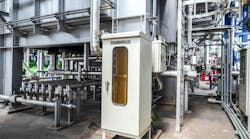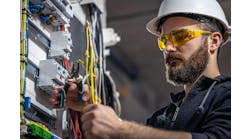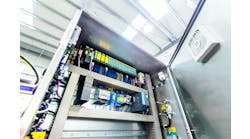How to seal the gap for effective liquid and dust protection in industrial enclosures
This is Part II of a two-part series on industrial enclosures. Read Part I.
One of the main concerns with enclosures in wet environments is that water or other liquid can lay in the gap between the cabinet door and the cabinet itself. There is a gasket there to ostensibly keep moisture and dust out, but it also creates a catch point where those elements will sit for long periods.
Liquid and debris, of course, will mix over time and create a substance that is difficult to clean. It can also work on the gasket over time and break down the base material. Vendors have come up with some ways to deal with this issue.
One method is to change the design of the door to bring the flange of the cabinet out to the inner edges of the door profile. By doing this, the gasket is protected from prolonged exposure to the liquid and dust/product. If the liquid lays in the crevice between the body of the enclosure and the extended flange, then it is minimal and has an opportunity to move away better.
Another way that helps with liquid removal is to slope the top of the enclosure. While this usually means that the inner panel will not be as big as the back surface of the enclosure, it does improve the ability to shed water off the top. The door itself may be sloped to match the slope of the enclosure to further help with this feature.
Yet another way to improve the removal of water is to extend the top of the enclosure over the top edge of the door. Imagine the overhang on your house to push water away from the front door before dropping off.
A combination of all three methods greatly improves the ability to keep water off the enclosure and improves both the integrity of the seal and the cleanliness of the top of the enclosure.
Gaskets perform the important function of providing a semi-rigid barrier that takes up any gaps between the door and the enclosure. Two common materials from which gaskets are made is silicone and ethylene propylene diene monomer (EPDM). Silicone is a synthetic elastomer that stands up well to temperature and has low reactivity with chemicals. They come in a variety of durometers, or hardness, and colors. EPDM is also a synthetic polymer that is resistant to sunlight, ozone, abrasion, cutting and tearing, so it is more resilient than silicone. Neither does well with exposure to gasoline or oil products.
Thermoplastic elastomers (TPEs) behave like beefed-up EPDM but are more costly to produce. Fluorosilicone gaskets are an improvement over silicone with the benefit of better resistance to oxidizing chemicals, as well as gas and oil products.
A more recent improvement is the introduction of a dual seal. Both the door and the enclosure have a gasket installed. The door gasket mates up with the frame of the enclosure, when closed, while the enclosure gasket mates up with the inside surface of the door. This double dam, as it were, greatly improves the ability to keep liquid and dust contaminants from getting inside an enclosure.
It is a good idea to institute a periodic inspection of all enclosures after installation to confirm the integrity of the seal and any penetrations of the surface from normal application like conduits and operator buttons, operator control screens and signal lights.
At time of installation, all of these items should match the NEMA rating of the enclosure itself, but time and use may compromise the initial seal and need to be tightened up or replaced. Most manufacturers of electrical enclosures make replacement gasket kits.
When applied according to the manufacturer’s instructions, these are just as good as the original seal. If in doubt, the manufacturer might also offer the ability to order replacement doors with the gasket material applied as it would on a completely new enclosure.
This is far more cost-effective than replacing the entire enclosure with door and avoids the need to pull back the existing connections and punch new holes in an enclosure.
A final word about enclosures: They do not have to be just for electrical components. In packaging machinery, we often use windowed enclosures to contain and protect pneumatic manifolds. NEMA rated panel-mount couplings can be used to transition the enclosure and provide a solid connection to the ports on the manifold.
By using a windowed enclosure, the status of the valves can be viewed without the need to open the door and expose the components to the environment outside the enclosure.





